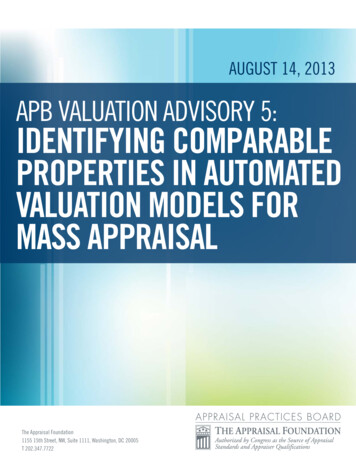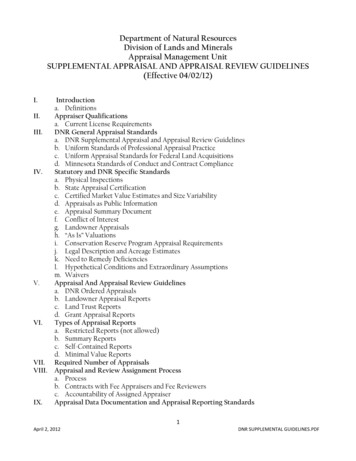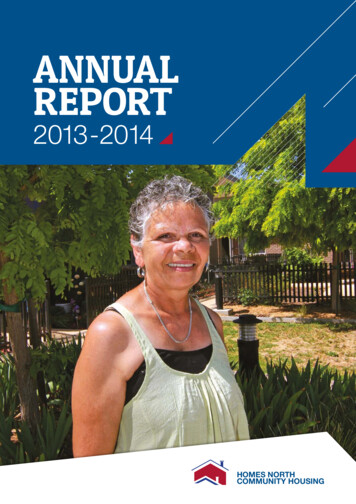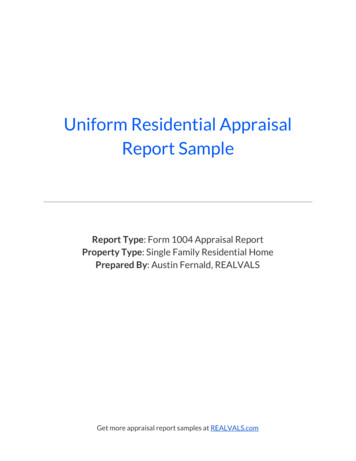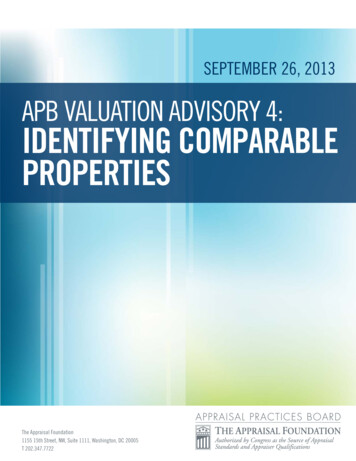
Transcription
SEPTEMBER 26, 2013APB VALUATION ADVISORY 4:IDENTIFYING COMPARABLEPROPERTIESThe Appraisal Foundation1155 15th Street, NW, Suite 1111, Washington, DC 20005T 202.347.7722
Revised APB Valuation Advisory #4Identifying Comparable PropertiesThis communication is for the purpose of issuing guidance on recognized valuationmethods and techniques. Compliance with such guidance is voluntary, unless mandatedthrough applicable law, regulation, or policy.Important Note: This revised APB Advisory #4 is being issued to make edits to a SupremeCourt Case citation on page 9 for the Mississippi & Rum River Boom Co. v. Patterson, 98 U.S. 403 (1878). Additional edits were made to add complete text titles and correct pagereferences in the Glossary of Terms and Definitions beginning on page 13.Date Issued:September 26, 2013Application:Residential and Non-residential Real PropertyIssue: As part of its ongoing responsibilities, the APB is tasked with identifying whereappraisers and appraisal users believe additional guidance is required. One such issueidentified by the APB is identifying comparable properties. Comparability analysis is afundamental study in determining property value. This analysis involves a side-by-sideexamination of physical and transaction characteristics of the identified comparable propertiesrelative to the subject. The reliability of this valuation technique relies heavily on the properselection of suitable comparable properties.This guidance discusses the terms and definitions associated with a comparable property, thecharacteristics generally considered for determining comparability; and the degree of suitabilityof a property as a comparable.The guidance addresses whether there is a threshold of differences, which based on theirmagnitude, automatically disqualifies a property as comparable.The guidance examines a closely related topic; the differences between the terms, “market area”and “neighborhood” and a broad summary of the characteristics to consider for delineating amarket area.APB Valuation Advisory #4 - Identifying Comparable Properties 2014 by The Appraisal Foundation. All Rights Reserved.1
With regard to the use of “distress sales” (e.g., short sales, foreclosures) please see APBValuation Advisory #3, Residential Appraising in a Declining Market. The Board is alsoconsidering developing guidance on the valuation of new residential construction.Subject Matter Experts: The Appraisal Practices Board and The Appraisal Foundation wish toexpress our sincere gratitude to each of the following Subject Matter Experts for volunteeringtheir time and expertise in contributing to this document:Grant AustinAnthony GrazianoMichael IrelandKaren ObermanJo Anne TrautOrlando, FloridaMiami, FloridaBloomington, IllinoisClive, IowaBrookfield, WisconsinAPB Liaisons: Guy Griscom and John S. MarrazzoThe APB would like to express its thanks to Gary Taylor, former APB Chair, for hisparticipation and direction on this project.Identifying Comparable PropertiesTABLE OF CONTENTSSectionIssuePageIIntroduction3IIProperty Characteristics3IIIComparable Suitability5IVMarket Area and Neighborhood Characteristics9VSummary11VIGlossary of Terms and Definitions12APPENDIX I: Examples of Physical Comparability Factors15APPENDIX II: Suggested Further Reading16APB Valuation Advisory #4 - Identifying Comparable Properties 2014 The Appraisal Foundation2
Identifying Comparable PropertiesI.Introduction12345678910Real property valuation considers three approaches to value which are distinctly different giventheir underlying foundational premises. However, all three approaches rely on a comparabilityanalysis in developing credible results under each approach. The Sales Comparison Approachprovides an indication of value based on units of comparison derived from sales of similar orcomparable properties. The Cost Approach requires land value comparability analysis, costcomparability analysis, and market extracted depreciation comparability. The Income Approachrequires income/lease comparability, expense comparability, income potential comparability,capitalization rate, and minimum acceptable rate of return on investment comparability. All ofthe above approaches rely on the same fundamental underpinnings of determining“comparability.”111213Therefore the identification of what constitutes a similar, or “comparable property” is critical tothe proper application of the three approaches to value. In this Advisory we will provideguidance to assist in the identification of comparable properties.II.Property Characteristics14151617181920The principle of substitution is the foundation of comparability. It states that a rational buyerwill not pay more for an item than the cost of an acceptable substitute. 1 The appraiser mustanalyze transactions of closed sales, pending sales, and listings of properties and determinewhich are acceptable substitutes by weighing the elements of comparison. In developing anopinion of value for the subject property, the appraiser attempts to answer the question “Whatwould a buyer of the comparable property have paid for the subject property given the observedsale price (or asking price, in the case of a listing) for the comparable property?”2122232425Generally speaking, the more similar a competing property is to the subject property, the better.A high degree of similarity in property characteristics between the subject property and theavailable properties improves comparability. Many courts recognize “.that ‘similar’ does notmean ‘identical,’ but means having a resemblance, and that property may be similar in the sensein which the word is here used though each possesses various points of difference.” 2262728293031The appraiser weighs the relevance of the property characteristics (including, but not limited to:location, economic, legal and physical factors) based on the importance assigned by marketparticipants. The most relevant property characteristic(s) are then examined on each availableproperty. By examining and weighing the relevant property characteristics, the appraiser isbetter prepared to select the most appropriate comparable properties available. Another court hasdefined a comparable property as one that “Has similar use, function, and utility; is influenced by12Adapted from The Appraisal of Real Estate, 13th Ed., pp. 38-39.City of Chicago v. Vaccaro, 97 N.E.2d 766, (Ill. 1951).APB Valuation Advisory #4 - Identifying Comparable Properties 2014 The Appraisal Foundation3
3233the same set of economic trends and physical, governmental, and social factors; and has thepotential of a similar highest and best use.” 3343536373839Because real property is truly unique, there are always differences between the property underanalysis and the selected competing properties used for comparative purposes. Whenconsidering a property as a comparable, the appraiser should first ask “Is the propertysufficiently similar, in all fundamental aspects to the subject property?” This leads to the criticalanalysis of evaluating the property characteristics that make a property sufficiently similar. Thefollowing chart below summarizes the primary elements of comparison:Elements of ComparisonDescriptionLocation (Market Area) AspectsOther than market conditions at the time of sale, location is themost distinctive element of property analysis. Would a potentialbuyer of the subject consider the comparable property as a potentialsubstitute given its location within the market area?Economic AspectsEconomic aspects include seller concessions, buyer’s expectedexpenditures after sale, financing considerations to reflect “cashequivalent” pricing. In lease comparability, economic aspectsmight include reimbursement terms, landlord amortization of tenantimprovements, etc.Also, includes market conditions: especially time, which is anelement of all property analysis. Did the comparable transactionoccur under similar market conditions as the subject property’s dateof analysis? What are the driving elements which differ andcontribute to the adjustments necessary to infer pricing within thecurrent market?Legal AspectsComparability of property title and occupancy tenure, generallyexpressed as “interest appraised”Highest and Best Use: significant effort should be given to comparesimilar transactions based on the subject property’s highest and bestuse.Physical Aspects3Each type of real estate (residential and non-residential) hasphysical characteristics which are desired or required by buyers.Different market areas demonstrate different buyer preferences withrespect to cost/value of physical property characteristics. Anexhaustive list could be compiled considering all of the variousphysical elements by asset class which might be measured andcompared. What is significant to the analysis are those elementsthat contribute to measurable price differences in the market. Asummary listing of typical major physical elements of comparisonby asset class is provided as a supplement to this table.Montana Code Annotated 2011, 15-1-101, retrieved from on 08/26/2012.APB Valuation Advisory #4 - Identifying Comparable Properties 2014 The Appraisal Foundation4
III.Comparable Suitability40414243Sales information 4: Before a property can be considered a comparable, the appraiser mustconfirm the type of sale transaction. In other words, did the sale occur under conditionscommensurate with the type and definition of value under consideration? “n the case of marketvalue, the following factors must be considered:44451. Did the sale convey property rights similar to the property rights being appraised? Werethe property rights similarly encumbered or unencumbered at the time of sale?462. Were both the buyer and seller typically-motivated?47483. Were both parties well informed or advised and each acting in what they considered theirown best interests?494. Was the property allowed exposure in the open market for a reasonable length of time?505. Was payment made in cash or its equivalent?51526. Was financing, if any, on terms generally available in the community at the time of saleand typical for the property type in its locale?5354557. Did the price represent normal consideration for the property sold unaffected by specialfinancing amounts and/or terms, services, fees, costs, or other credits incurred in thetransaction?” 5565758The appraiser’s experience and skill in consistently observing the market coupled with ongoinginterviews with buyers, sellers, and brokers as to what factors drive local values assist inproviding credible value indications by comparison.596061626364In addition to closed sales, knowledge of listings and pending (under contract) properties may beused to demonstrate the most current market activity and current competition considered bypotential buyers. Because the final conveyance amount is unknown, listing comparables andpending sales should be used cautiously, but are often helpful: (a) in establishing the upper limitof probable value in the final reconciliation, or (b) as guidance in times of rapidly changingmarket conditions.65666768697071The appraiser cannot control the quality or suitability of the activity available in the marketduring the timeframe of analysis. Information could be limited in many markets, and manyproperties do not lend themselves to simplified comparison. In such cases, analysis of oldertransactions may also be required due to limited current activity in the market; however, suchdata should be cautiously considered. It is necessary for the appraiser to clearly express theselimitations and to reconcile the reliability of the approach where a substantial number of theelements are sufficiently different.7273Magnitude of adjustments: In markets where competing properties are highly similar to thesubject property, it is unlikely that large and/or numerous adjustments would be required.45Sources of sales information are discussed in APB Valuation Advisory #2: Adjusting Comparable Sales For SellerConcessions.Real Estate Valuation in Litigation, 2nd Edition, pp. 204-205.APB Valuation Advisory #4 - Identifying Comparable Properties 2014 The Appraisal Foundation5
7475However, in markets that are less homogeneous or have limited market activity, it is possible thatlarge and/or numerous adjustments may be necessary.7677When a comparative analysis requires large and/or numerous adjustments, questions may ariseregarding the true comparability of the property.78798081828384858687At what point is a competing property not considered comparable? While there is no singlesource to determine comparability, it is up to the appraiser within the context of the scope ofwork to determine whether the property is comparable and will lead to credible assignmentresults. Consideration of the quantity and magnitude of adjustments may assist in identifyingwhen a property becomes suspect as a comparable; however, this does not conclusively result insuch a determination. “The degree of similarity varies from case-to-case, so neither appraisersnor the courts can arrive at a formula to test comparability or similarity. In one instanceadjustments totaling 15% of the sale price may indicate that the property is, in fact, not acomparable sale, but in another instance a sale with total adjustments equaling 15% of the saleprice might turn out to be the most comparable sale available.” 6888990In summary, the appraiser identifies the comparability of the property by determining whether itis a competitive substitute for the subject property. The quantity and/or magnitude of theadjustments may not dictate comparability.9192939495Some of the most common written guidelines on this issue are the appraisal underwritingguidelines issued by Government Sponsored Enterprises (GSE) (e.g., Fannie Mae). It isimportant to recognize that these appraisal guidelines are written primarily to determine whetheror not a property is eligible for purchase on the secondary mortgage market, and not as adefinitive tool to determine comparability.96979899100GSE guidelines also apply exclusively to residential properties, generally speaking the mosthomogeneous property class nationally with sufficiently similar properties transacting within theshortest period of time. It is typical to find that appraisals of non-residential properties, complexresidential properties, and properties in unstable markets require the use of comparableproperties that may possess greater differences.101102103104105106According to Fannie Mae, a property is comparable if the market considers it a competitivesubstitute. Once a property is determined to be comparable by the appraiser, then appropriateanalysis and market adjustments are applied. “Analysis and adjustments to comparable salesmust be based on market data for the particular neighborhood and for competing locations – noton predetermined or assumed dollar adjustments. Adjustments must be made without regardfor the percentage or amount of the dollar adjustments.” 7 (Bold added for emphasis.)107108109110111The key is for the appraiser to adequately explain and support the rationale for using thecomparable properties selected in the appraisal report. Such narrative assists in demonstratingthe reliability and credibility of the opinion of value. Where the comparable properties possesssignificant differences from the subject property, additional comparable properties may beincluded for additional support of the opinion of value.67Real Estate Valuation in Litigation, 2nd Edition, p. 0. 08/29/2012.APB Valuation Advisory #4 - Identifying Comparable Properties 2014 The Appraisal Foundation6
112113114115Appropriate analysis, consideration, and explanations are necessary regardless of the amount ofan adjustment. If numerous adjustments or a singular atypical adjustment is required, then anexplanation and support (i.e., stating search criteria and results) regarding the lack of more“similar” properties that require fewer adjustments should be explained.116117118119120121122If the subject property has a significant element of comparison that competing properties lack orconversely, if the subject property lacks a significant element of comparison that competingproperties possess, explanation is necessary. In such situations, generally recognized appraisalmethodology would dictate an effort to use comparable properties that are both superior andinferior to the subject for that specific element of comparison (this process is often referred to as“bracketing”). Comparing properties with superior, similar, and inferior elements of comparisonto the subject property may assist in validating the adjustments applied.123124125126Following is an illustration of bracketing on two physical features of a residential subjectproperty. The features bracketed in this illustration are the subject property’s gross living areaabove grade and the garage count. This is a generalized illustration of the sales comparisonanalysis focusing on these two units of comparison only (highlighted in yellow).127128129In the following example, the subject property’s gross living area (GLA) was measured at 2,200sq. ft. The GLA feature is bracketed by comparable property # 1 that has an inferior GLA at1,950 sq. ft. and by comparable property # 2 that has a superior GLA at 2,500 sq. ft.130131132Similarly, the subject’s 1-car garage amenity is bracketed by comparable property # 1 that has asuperior garage count of 2-cars and by comparable property # 2 that has an inferior garageamenity of no garage.133134135The comparable sales’ inferior features in comparison to the subject property’s features wereadjusted upward (positive) and conversely, the comparable sales’ superior features in comparisonto the subject property’s features were adjusted downward (negative).APB Valuation Advisory #4 - Identifying Comparable Properties 2014 The Appraisal Foundation7
SubjectComp 1 / AdjustmentSales PriceNoneNotedLocationSite SizeViewQuality ofConstructionNumber ofBedroomsNumber ofBathroomsAboveGrade GLAN;Res;10500 sfN;Res;N;Res;10500 sfN;Res;N;Res;10500 sfN;Res;N;Res;10500 .122001950Basement1200sf0sfin1 CarGarage1200sf0sfin2 CarGarage2500 180,000(5,000)No Garage 184,500Sales PriceNoneNoted(9,000)209012,0001200sf0sfin2 CarGarage1200sf0sfin / AdjustmentComp 3 183,000NoneNoted7,500Sales PriceNoneNoted / AdjustmentSales PriceSellerConcessionsGarageAdjustedSales Price 182,000Comp 2 185,0003,300(5,000) 183,000 183,300136137138139In this illustration, the subject’s sale price of 183,000 is also bracketed by the pre-adjusted salesprices of the comparable properties ( 180,000 to 185,000). Both downward and upwardadjustments are applied resulting in the adjusted sale price range of 183,000 to 184,500 (thevalue bracket of probable range) for the subject property.140141142143144145When a sales comparison approach requires substantial and varied adjustments, thereconciliation should enable the reader to understand why the sales were used. Adequatereconciliation is a required and integral part of any value conclusion. Standards Rule 1-6(a) ofthe Uniform Standards of Professional Appraisal Practice 8 states: “In developing a real propertyappraisal, an appraiser must reconcile the quality and quantity of data available and analyzedwithin the approaches used.” 9146147148149150151152153154Highest and Best Use: A necessary consideration for determining if a property is comparable iswhether the highest and best use of the subject property and the competing property is the same.“Appraisers have a special responsibility to scrutinize the comparability of all data used in avaluation assignment. They must fully understand the concept of comparability and shouldavoid comparing properties with different highest and best uses, limiting their search forcomparables, or selecting inappropriate factors for comparison.” 10 Likewise, the Supreme Courtof the Unites States in Mississippi & Rum River Boom Co. v. Patterson, 98 U.S. 403 (1878),states that the highest and best use of a property should consider a change in current use of aproperty “by reference to the uses for which the property is suitable, having regard to the existing8UNIFORM STANDARDS OF PROFESSIONAL APPRAISAL PRACTICE (USPAP) 2012-13 Edition p. U-20.Ibid10The Appraisal of Real Estate, 13th Edition. p. 170.9APB Valuation Advisory #4 - Identifying Comparable Properties 2014 The Appraisal Foundation8
155156157business or wants of the community, or such as may be reasonably expected in the immediatefuture.” These factors can be applied to both the subject property and the selection ofcomparable properties.158IV.159160161162163164Location is a primary consideration in the comparable property selection process. Ideally, acomparable property would compete with the subject property in location as well as othercharacteristics. When considering a comparable property’s location competitiveness to thesubject property, the subject property’s local market performance and characteristics aremeasured alongside the comparable property’s local market. Preferably, the comparableproperty is located in the subject property’s market area.165166167168169170171172While the terms market area and neighborhood are often used interchangeably, in truth, the twoterms have distinctly different meanings, in both residential and non-residential appraising.Data and analysis related to a neighborhood is broad and general in nature, whereas data andanalysis related to a market area is specific and related to a particular property type or category. 11The confusion between these two concepts arises in practice because the method of delineationfor both a market area and a neighborhood follow the same four basic principles. Both can bedefined by their physical boundaries (man-made and natural) and their intangible boundaries(social and 186Appraisers make a distinction between the neighborhood in which a property is situated and themarket area in which comparable properties will be found are located. Market area is formallydefined as “the geographic or location delineation of the market for a specific category of realestate, i.e., the area in which alternative, similar properties effectively compete with the subjectproperty in the minds of probable, potential purchasers and users. In contrast, a neighborhood isdefined more generally as ‘a group of complementary land uses.’” 12 In other words, theneighborhood boundaries in which the subject property is located may contain residentialproperties as well as non-residential properties that serve the residents of the neighborhood,whereas the boundaries of the market area for the subject property is based on the area in whichsimilar properties compete with one another. In some cases, the subject property’s neighborhoodand market area may have the same boundaries, but in other cases the market area may containseveral neighborhoods or portions of different neighborhoods. A market area is defined by thetype of property, the type of transaction (rental or sale), the geographic area in whichcompetition exists, and the homogeneity of properties within its boundaries. 13187188189190191192193The geographic area used for selecting comparable properties depends on the property type. Fora large industrial property, regional or national market areas may be relevant since this is the“market” in which buyers of similar properties effectively compete. For a (non-complex)residential property, adequate sales data may be available within a few blocks of the subjectproperty. 14 Neighborhoods tend to define the primary market area for most non-complexresidential properties since homes in the area immediately surrounding a property tend to attractlike-minded buyers. However, it is recognized that competitive neighborhoods within a largerMarket Area and Neighborhood Characteristics11Appraising Residential Properties, 4th Ed., p 36, 78, and 198.Ibid.13Ibid.14The Appraisal of Real Estate, 13th Edition, p.16912APB Valuation Advisory #4 - Identifying Comparable Properties 2014 The Appraisal Foundation9
194195market area might need to be considered. Care should be taken to analyze and align the specificneighborhood characteristics to ensure they are truly competitive.196197198199200201202How a market area and neighborhood may be the same or differ: A subdivision comprised oftract housing of similar general design and covering ten square blocks may be a ‘neighborhood’and the ‘market area’ if there are no other similar developments nearby. However, a ‘marketarea’ may also encompass other subdivisions that are suitable alternatives and draw from thesame buyer pool as the subject, even if they are across town. The buyer pool ultimately definesthe market area; if buyers consider the neighborhoods to have similar appeal, then it is likely theneighborhoods are suitable competition and could be considered within the same market area.203204205Non-residential properties may have demand drivers from diverse locations. “Thus, delineatingthe market areas for these uses usually starts with identifying the competitive cluster of buildingsthat compete for some of this diverse market of users.” 15206207“The term market area may be more relevant to the valuation process than either neighborhoodor district for several reasons:208209-Using the umbrella term market area avoids the confusing and possibly negativeimplications of the other terms.210-A market area can include neighborhoods, districts, and combinations of both.211212213214-Appraisers focus on market area when analyzing value influences. A market area isdefined in terms of the market for a specific category of real estate and thus is the area inwhich alternative, similar properties effectively compete with the subject property in theminds of probable, potential purchasers and users.” 16215216217218Delineating precise market area boundaries is challenging because markets may overlap and itmay be difficult to decide how narrowly or broadly to define a market area. Therefore, thissection is intended to assist in identifying potential market characteristics for identifying amarket area, but not to present the techniques for delineating and segmenting a market area.219220221222Market characteristics that delineate a market area: “The market area for the buyer/sellermarket is usually different from the market area for the user market. The market area for thebuyer/seller market could be international, say, for a hotel, while the user market for the hotelcould be within the country. Thus, market delineation for valuation has two main parts:2231. Analysis of the user market (owners, occupants, and the competition)2242. Analysis of the buyer/seller market.” 17225226227“The user market is identified before the buy/sell market is determined because the user marketsets the basis of highest and best use, which in turn sets the parameters of the substitute propertycomparables identified in the buy/sell market.” 1815Fanning, Steven F., Market Analysis for Real Estate: Concepts and Applications in Valuation and Highest andBest Use, Appraisal Institute, Chicago, 2005.16The Appraisal of Real Estate, 13th Ed., p. 55.17Ibid, p.174.18Fanning, Steven F., Market Analysis for Real Estate: Concepts and Applications in Valuation and Highest andBest Use, Appraisal Institute, Chicago, 2005.APB Valuation Advisory #4 - Identifying Comparable Properties 2014 The Appraisal Foundation10
228229230Possible demographic, socio-economic, lifestyle, geographic, and economic characteristics toconsider in segmenting markets is listed below (not an exhaustive list and not in any specifiedorder):231 the type of structures and architectural style232 current land use233 typical site size234 tenure and vacancy rates235 income levels (average/median incomes/range of incomes)236237 geographic characteristics (climate, natural resources, natural recreational opportunities,etc)238 population trends and rate of growth239 median prices and price range distribution240 economy (jobs, industries, diversification, growth, tax district, etc.)241 cultural and entertainment opportunities242 educational resources available (including school districts)243 infrastructure244 affordability245 availability of necessary services (hospitals, public transportation, utilities, etc)246 exposure to nearby properties (secluded or densely improved)247 absorption rates, demand, and market times248 condition and quality of residential and/or non-residential properties249 sustainability (green) features or characteristics250 rental rates251 historical renovations or newly built housing/non-residential properties252 typical building or housing size253 demographic components (family mix, age, purchasing power, etc.)254255256257The segmenting of a market should take into consideration these or similar applicable datacategories that are considered most relevant for the property type and use. Demographic, socioeconomic, consumer behavior, economic, and lifestyle data can be retrieved or purchasedthrough several available private and public resources, both locally and nationally.258V.259260Summary The identification of what constitutes a similar, or “comparable property” is critical to theproper application of the three approaches to value.APB Valuation Advisory #4 - Identifying Comparable Properties 2014 The Appraisal Foundation11
261262263 The appraiser identifies the comparability of the property by determining whether it is acompetitive substitute for the subject property. The quantity and/or magnitude of theadjustments do not dictate comparability.264265266267268269 The appraiser has to adequately explain and support the rationale for using thecomparable properties selec
59 In addition toclosed sales, k nowledge of listings and pending (under contract) properties may be 60 used to demonstrate the most current market activity and current competition considered by 61 potential buyers. Because the final conveyance amount is unknown, comparables listing and 62 pending sales should be used cautiously, but are often .


